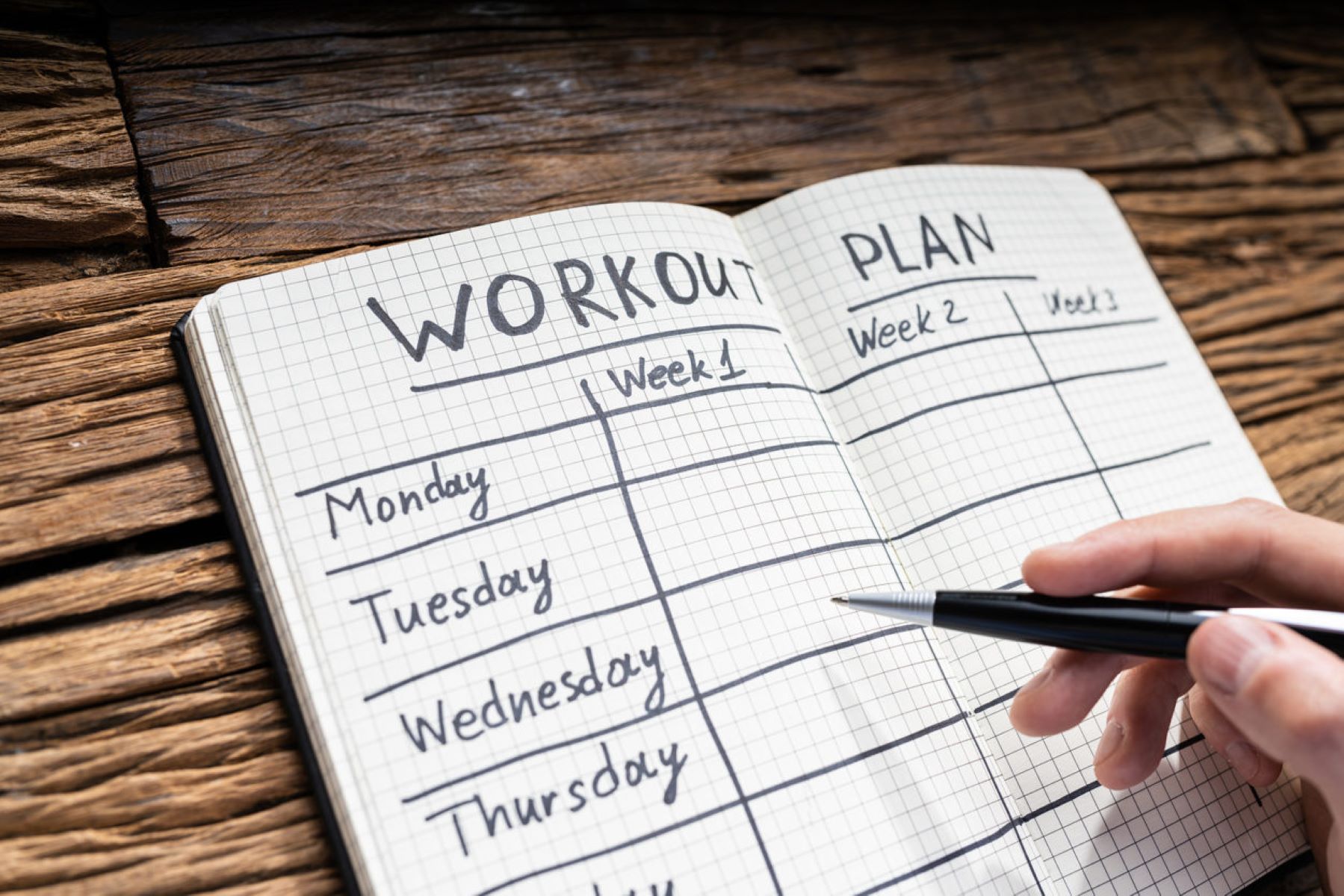

Featured
How Often Should I Workout A Week
Modified: January 2, 2024
Discover the ideal workout frequency for optimal results with our featured guide on how often you should work out per week. Enhance your fitness routine and maximize your gains today!
Introduction
Maintaining a consistent workout routine is crucial for achieving our fitness goals, but determining how often we should work out can be a bit tricky. With so many conflicting opinions and advice available, it’s important to understand the factors that influence our optimal workout frequency. Whether you are a fitness enthusiast or a beginner looking to adopt a healthier lifestyle, finding the right balance is key.
We all have different fitness goals, lifestyles, and physical capabilities, so there is no one-size-fits-all answer to the question of how often we should work out. It’s important to consider our individual needs and preferences while also taking into account evidence-based guidelines. By doing so, we can design a workout plan that is both effective and sustainable in the long run.
In this article, we will explore the various factors to consider when determining our workout frequency, provide guidelines for weekly workouts, discuss the frequency requirements for different fitness goals, highlight the benefits of regular exercise, and address some common mistakes to avoid. By the end, you’ll have a clearer understanding of how often you should work out and be ready to create a workout routine that fits your unique needs and goals.
Factors to Consider
When determining how often we should work out, there are several key factors that we need to take into consideration. These factors will help us determine the appropriate frequency and intensity of our workouts, ensuring that we stay motivated, avoid injury, and make progress towards our goals.
- Fitness Level: Your current fitness level plays a significant role in determining how often you should work out. Beginners may need more rest days and lighter workouts to allow their bodies to adapt, while more experienced individuals may be able to handle more frequent and intense training sessions.
- Goals: The goals you have will also influence your workout frequency. If your primary goal is to maintain overall health and fitness, a few moderate-intensity workouts per week may be sufficient. However, if you have specific goals such as building muscle or improving cardiovascular endurance, you may need to increase the frequency and intensity of your workouts.
- Time Availability: The amount of time you can dedicate to exercise each week will impact how often you can work out. If you have a busy schedule, you may need to find creative ways to fit in shorter, more intense workouts. On the other hand, if you have more flexibility, you might be able to schedule longer sessions and incorporate additional rest days.
- Recovery Ability: Recovery is a vital component of any exercise routine. Your body needs time to repair and rebuild after intense workouts. If you find that you are excessively sore, fatigued, or experiencing a decline in performance, it may be a sign that you need more rest days in between workouts.
- Individual Preference: Listen to your body and consider your personal preferences. Some people thrive on daily workouts, while others prefer a more structured approach with designated rest days. Finding a workout frequency that you enjoy and can realistically maintain in the long term is key.
These factors are not exhaustive, and everyone is unique in terms of what works best for them. It’s important to adjust your workout frequency based on your own body’s signals and feedback. By considering these factors and tailoring your routine to your specific needs, you can create an exercise plan that is both effective and sustainable.
Guidelines for Weekly Workouts
Now that we have considered the factors that influence our workout frequency, let’s explore some general guidelines for structuring our weekly workouts. These guidelines provide a starting point that can be adjusted based on individual circumstances and goals.
- Cardiovascular Exercise: Aim for at least 150 minutes of moderate-intensity aerobic exercise or 75 minutes of vigorous-intensity aerobic exercise spread throughout the week. This can include activities such as brisk walking, running, cycling, swimming, or dancing.
- Strength Training: Engage in resistance training exercises at least 2-3 days per week. Focus on all major muscle groups, including the chest, back, arms, shoulders, legs, and core. Include both compound exercises, like squats and deadlifts, and isolation exercises, like bicep curls and tricep extensions.
- Flexibility and Mobility: Incorporate stretching exercises and movements that promote flexibility and mobility at least 2-3 days per week. This can include activities such as yoga, Pilates, or dedicated stretching routines.
- Rest and Recovery: Allow yourself at least one or two rest days per week to give your body time to recover and repair. Rest days are just as important as workout days for optimal progress and injury prevention.
- Listen to Your Body: Pay attention to how your body feels throughout the week. If you’re excessively fatigued, experiencing pain, or not recovering well, it may be a sign that you need to adjust your workout schedule. Additionally, don’t ignore any signs of overtraining, such as persistent muscle soreness, decreased performance, or changes in mood.
Remember, these guidelines provide a basic framework, and you should tailor them to your specific needs and goals. Additionally, gradually increasing the intensity and duration of your workouts over time can help prevent plateaus and promote continuous progression. Lastly, don’t forget the importance of proper nutrition, hydration, and sleep to support your workouts and overall fitness journey.
Frequency for Different Fitness Goals
The frequency of your workouts will largely depend on the specific fitness goals you have. Different goals require different training approaches to maximize results. Let’s explore the recommended workout frequency for common fitness goals:
- General Fitness: If your goal is to maintain overall health and fitness, aim for at least 3-5 days of moderate-intensity cardiovascular exercise per week, along with 2-3 days of strength training. This balanced approach will help improve cardiovascular health, maintain muscle mass, and enhance overall fitness levels.
- Weight Loss: To effectively lose weight, aim for a combination of cardiovascular exercise and strength training. Engage in at least 4-6 days of moderate-intensity cardio, such as running or cycling, along with 2-3 days of strength training to build lean muscle and boost metabolism.
- Muscle Building: If your goal is to build lean muscle mass, focus on resistance training. Aim for at least 4-6 days of strength training per week, targeting different muscle groups each day. Allow for adequate rest and recovery between sessions, as muscles need time to repair and grow.
- Endurance Training: For those aspiring to improve cardiovascular endurance, aim for 5-7 days of moderate to high-intensity aerobic exercise. This can include activities like running, swimming, or cycling. Incorporate longer duration workouts, interval training, and progressively increase intensity to challenge your endurance capacity.
- Flexibility and Mobility: If your goal is to improve flexibility and mobility, aim for 2-3 days of dedicated stretching, yoga, or Pilates sessions per week. Focus on exercises that target major muscle groups and help lengthen and strengthen the muscles.
It’s important to note that these recommendations are general guidelines and can be adjusted based on individual factors such as fitness level, time availability, and personal preference. Consulting with a fitness professional can also help tailor a workout program specifically for your goals and needs.
Benefits of Regular Exercise
Regular exercise offers a wide range of benefits that extend beyond just physical health. Incorporating consistent physical activity into our lives can have a profound impact on our overall well-being. Here are some of the key benefits of regular exercise:
- Improved Physical Fitness: Regular exercise helps improve cardiovascular health, enhance muscular strength and endurance, and increase flexibility and mobility. It can also help maintain a healthy body weight and reduce the risk of chronic diseases such as obesity, diabetes, and heart disease.
- Mental Well-being: Exercise has been shown to have a positive impact on mental health. It can help reduce symptoms of depression, anxiety, and stress. Regular physical activity stimulates the release of endorphins, which are known as “feel-good” hormones, promoting a sense of well-being and improving mood.
- Increased Energy Levels: Engaging in regular exercise can boost energy levels and combat fatigue. Physical activity improves circulation and oxygen delivery to the body’s tissues, leading to increased energy production and a decreased feeling of tiredness.
- Better Sleep: Regular exercise can help improve the quality of sleep. It promotes deeper and more restful sleep, allowing for better recovery and rejuvenation of the body and mind.
- Improved Cognitive Function: Exercise has been linked to enhanced cognitive function and memory. It promotes better blood flow and oxygenation to the brain, leading to improved mental clarity, focus, and overall brain health.
- Boosted Immune System: Regular physical activity can strengthen the immune system, making us less susceptible to common illnesses and infections. Exercise has been shown to improve the body’s response to pathogens and reduce the risk of chronic inflammatory diseases.
- Increased Confidence and Self-esteem: Regular exercise can boost confidence and self-esteem by improving body image, increasing strength and physical abilities, and achieving personal fitness goals.
These are just a few of the many benefits that regular exercise can provide. It’s important to choose activities that you enjoy and can sustain long-term to maximize these benefits. Remember, consistency is key, so find ways to incorporate physical activity into your daily routine and make it a lifelong habit.
Common Mistakes to Avoid
When it comes to working out, we all want to make the most of our time and effort. However, there are some common mistakes that people often make. By being aware of these pitfalls, you can avoid them and ensure that your workouts are safe and effective. Here are some common mistakes to avoid:
- Skipping Warm-up and Cool-down: Failing to warm up before a workout and skipping the cool-down afterwards can increase the risk of injury. Take the time to warm up your muscles with dynamic movements and stretches, and cool down with stretches to promote recovery and reduce muscle soreness.
- Overtraining: Pushing yourself too hard without allowing enough rest and recovery time can lead to overtraining. Overtraining can result in decreased performance, increased risk of injury, and burnout. Listen to your body and incorporate rest days into your routine.
- Not Varying Workouts: Doing the same exercises and routines repeatedly can lead to plateaus and boredom. Mix up your workouts by trying new exercises, changing the intensity or duration, and incorporating different training modalities to challenge your body and keep your workouts exciting.
- Improper Form: Using improper form during exercises can lead to injuries and diminish the effectiveness of the workout. Take the time to learn proper technique and focus on maintaining good form throughout your workouts. If needed, seek guidance from a qualified fitness professional.
- Setting Unrealistic Expectations: It’s important to set realistic goals and expectations for your fitness journey. Avoid comparing yourself to others and focus on your own progress. Remember that results take time and consistency.
- Ignoring Nutrition and Hydration: Exercise alone cannot compensate for a poor diet and inadequate hydration. Fuel your body with nutritious foods, stay hydrated, and ensure you are getting enough protein, carbohydrates, and fats to support your workouts and recovery.
- Not Listening to Your Body: It’s essential to listen to your body’s signals and adjust your workouts accordingly. If you’re feeling excessively fatigued, experiencing pain, or not making progress, it may be a sign to modify your routine or take a break.
By avoiding these common mistakes, you can maximize the effectiveness of your workouts, reduce the risk of injury, and achieve your fitness goals more efficiently. Always prioritize safety, proper technique, and listen to your body throughout your fitness journey.
Final Thoughts
Determining how often you should work out is a personal decision that should be based on various factors, including your goals, fitness level, time availability, and individual preferences. While there are guidelines to assist you in finding the right balance, it’s important to remember that there is no one-size-fits-all approach. What works for one person may not work for another.
Consistency is key when it comes to fitness. It’s better to have a regular workout routine that you can maintain in the long term rather than sporadic intense sessions that lead to burnout or injuries. Listen to your body, pay attention to your progress, and adjust your workout frequency accordingly.
Incorporating a mix of cardiovascular exercise, strength training, flexibility, and restorative practices such as stretching or yoga can help you achieve a well-rounded fitness routine. However, always consult with a fitness professional if you have any concerns or specific goals.
Remember that physical activity is not just about achieving a certain appearance. It’s about improving overall health, both physically and mentally. Regular exercise can boost your mood, reduce stress, enhance cognitive function, and improve quality of life.
So, take the necessary steps to prioritize your physical well-being by finding a workout routine that suits your needs, setting realistic goals, avoiding common mistakes, and striving for consistency. Embrace the journey towards a healthier and happier you, and enjoy the numerous benefits that regular exercise brings.









